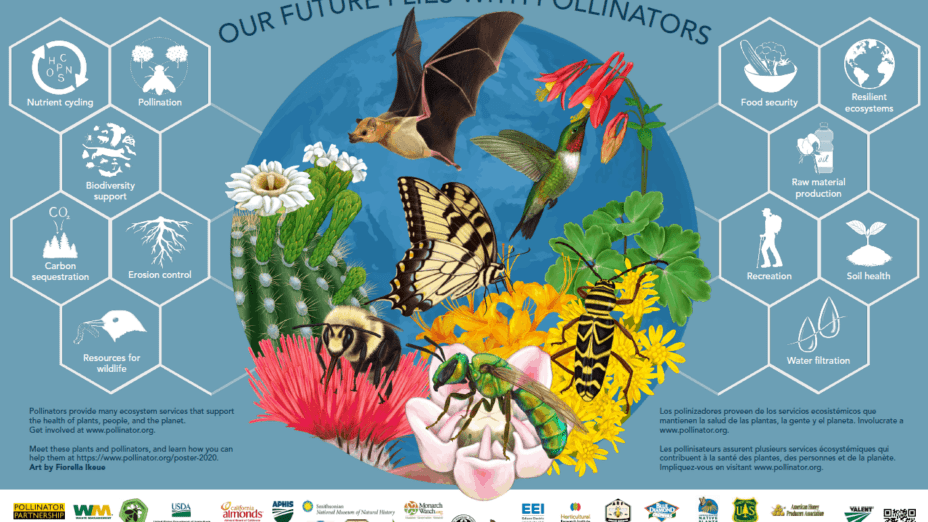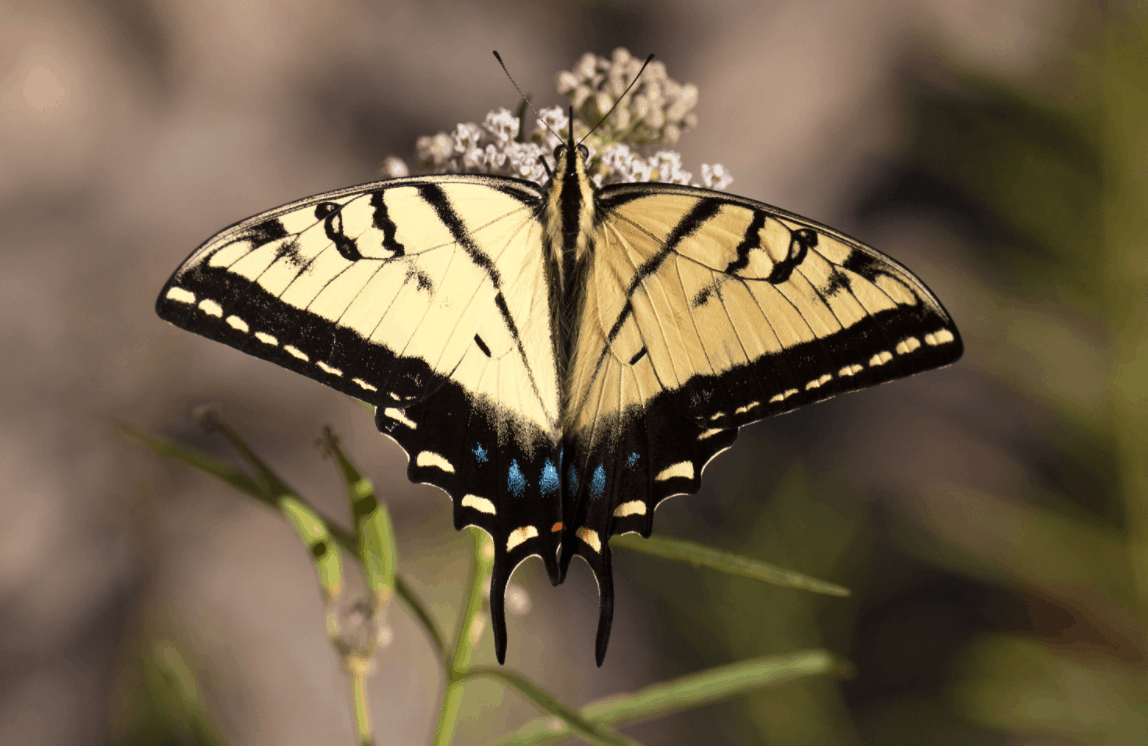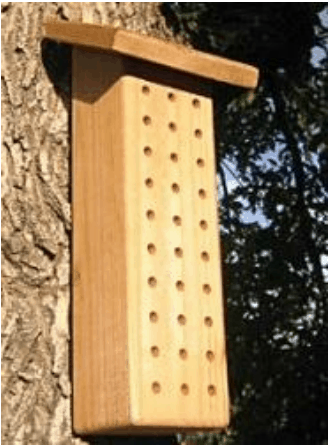
Thirteen years ago, the U.S. Senate’s unanimous approval and designation of a week in June as “National Pollinator Week” marked a necessary step toward addressing the urgent issue of declining pollinator populations. Pollinator Week has now grown into an international celebration of the valuable ecosystem services provided by bees, birds, butterflies, bats, and beetles.
What is pollination?

Two-tailed swallowtail on milkweed, Morgan Territory (Contra Costa County, California). Photo credit: Scott Hein
Pollination occurs when pollen grains are moved between two flowers of the same species, or within a single flower, by wind or animals that are pollinators.
Successful pollination, which may require visits by multiple pollinators to a single flower, results in healthy fruit and fertile seeds, allowing plants to reproduce. Without pollinators, we simply wouldn’t have many crops.
About 75 percent of all flowering plants rely on animal pollinators and over 200,000 species of animals act as pollinators.
Of those, about 1,000 are hummingbirds, bats, and small mammals. The rest are insects such as beetles, bees, ants, wasps, butterflies, and moths.
Why are pollinators important to us?
Pollinators are often keystone species, meaning that they are critical to an ecosystem. The work of pollinators ensures full harvests of crops and contributes to healthy plants everywhere.
Worldwide, approximately 1,000 plants grown for food, beverages, fibers, spices, and medicines need to be pollinated by animals in order to produce the goods on which we depend. An estimated one-third of all foods and beverages is delivered by pollinators.
Foods and beverages produced with the help of pollinators include blueberries, chocolate, coffee, melons, peaches, pumpkins, vanilla, and almonds. Plants that depend on a single pollinator species, and likewise, pollinators that depend on a single type of plant for food are interdependent. If one disappears, so will the other.
In the United States, pollination produces nearly $20 billion worth of products annually.
What everyone can do for pollinators
- Watch for pollinators. Get connected with nature. Register for one of Save Mount Diablo’s upcoming Discover Diablo hikes. Take a walk, experience the landscape, and look for pollinators midday in sunny, planted areas.
- Reduce your impact. Reduce or eliminate your pesticide use, increase green spaces, and minimize urbanization. If you must use pesticides, use the most selective and least toxic ones, and apply them at night when most pollinators aren’t active. Pollution and climate change affect pollinators, too.
- Plant for pollinators. Create pollinator-friendly habitat with native flowering plants that supply pollinators with nectar, pollen, and homes.
- Design your garden so that there is a continuous succession of plants flowering from spring through fall. Check for the species or cultivars best suited to your area and gradually replace lawn grass with flower beds.
- Plant native to your region using plants that provide nectar for adults plus food for insect larvae, such as milkweed for monarchs. If you do use non-native plants, choose ones that don’t spread easily, since these could become invasive.
- Select old-fashioned varieties of flowers whenever possible because breeding has caused some modern blooms to lose their fragrance and the nectar and pollen needed to attract and feed pollinators.
- Install “houses” for bats and native bees. For example, use wood blocks with holes or small open patches of mud. As little as 12 inches across is sufficient for some bees.
- Supply water for all wildlife. A dripping faucet or a suspended milk carton with a pinhole in the bottom is sufficient for some insects. Other wildlife need a small container of water. Refill containers daily or bury a shallow plant saucer to its rim in a sunny area, fill it with coarse pine bark or stones and fill to overflowing with water.
- Share fun facts, such as: a tiny fly (a “midge”) no bigger than a pinhead is responsible for the world’s supply of chocolate; or one out of every three mouthfuls of food that we eat is delivered to us by pollinators.
How to Build a Bee Condo
Many of the wild bees you may encounter in your backyard garden make their burrow homes in the soil. Some bees create hives in snags (dead or dying standing trees, often with their branches broken off), or in holes in trees. You can also encourage bee-residents by providing man-made nesting blocks or “bee condos.”

Bee Condo. Photo credit: Pollinator Partnership
Materials:
- 4”x6” or 6”x6” dried pine or fir post (or you can try a weathered fence post or other scrap wood)
- Drill and drill bits, a variety of diameters, ranging from 1/4 inch to 3/8 inch
- Paper straws—not plastic (available at some hardware stores, or through a scientific supply store), or small hollow sticks, with one end sealed
- A warm location protected from rain and predators
How to do it:
- Cut the wooden posts into blocks eight to 12 inches long.
- Drill holes into the wood blocks using a variety of hole diameters from 1/4 inch to 3/8 inch. Drill holes three to five inches deep, and at least 3/4 inch apart. Smooth out ragged edges of holes.
- Alternatively, a bundle of paper straws or hollow sticks, with one end sealed, will make an attractive bee home.
- Bees prefer dark colored homes, so consider charring the front of your “bee condo” lightly with a torch.
- Mount your “bee condo” on a post or attach to the side of a building. Place nesting blocks so that tunnels are horizontal. Make sure they are in a warm location with southern exposure and protected from rain. A good place could be under the eaves of a garage or shed.
Information for this post reproduced with permission from Pollinator Partnership.

